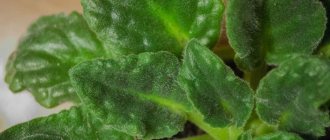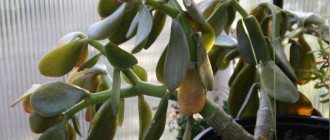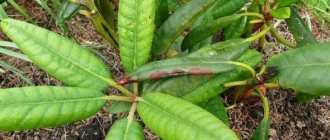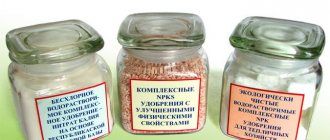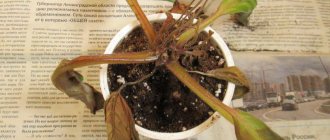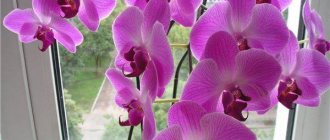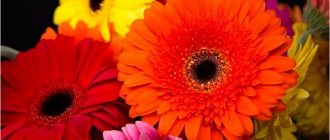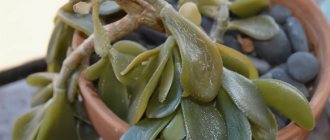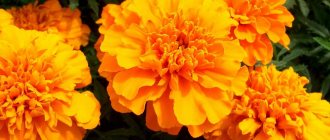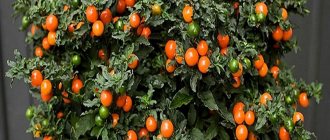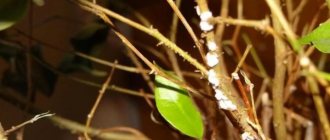Flowers
Gloxinia has won the hearts of flower growers around the world thanks to its flowers. Flowering for the most part lasts a long time. But it happens that by mid-summer gloxinia stops flowering. And here many will ask the question, how to resume flowering?
And there is such a way - you need to cut the stem just above the first pair of leaves, after the last flowers have withered. Also, do not forget to additionally feed the plant.
After a short time, new shoots will appear, and then the plant will delight you with new buds. The reblooming period is usually shorter, and the flowers are not as large and bright.
The no longer blooming gloxinia, as before, needs sufficient watering and fertilizing.
What to do for prevention?
In order to prevent various leaf lesions in gloxinia, it is always necessary to carry out prophylaxis.
- Firstly, irrigation must be carried out at the right time, when the plant itself needs it. In this case, there will be no overdrying or flooding of the soil.
- Secondly, do not place the plant where the bright rays of the sun fall on it.
- Thirdly, before planting gloxinia tubers in the ground, they should be pre-treated.
- And fourthly, you need to monitor the humidity in the room where the flower is located.
Gloxinia leaf diseases and treatment, use of insecticides, video
Blueberry diseases and their treatment
The advantages of gloxinia flower growers rightly include not only large bell flowers, but also the velvety foliage that forms the lush above-ground part of the plant.
If there is gloxinia in your home collection, leaf diseases and treatment of their consequences can take a lot of time from the gardener.
Fungal and bacterial infections, care errors and pests threaten the flower with serious damage and even death.
Gloxinia diseases. Fungal diseases of gloxinia leaves and their treatment
The most dangerous, rapidly developing and intractable diseases are caused by pathogenic fungi. Their spores are carried by the wind and land on plants with drops of water or soil particles. Pathogens can be introduced from a tool, loosening the soil or replanting a tuber.
More often than others, gloxinias are attracted to late blight fungi. Leaf disease on gloxinia appears as brownish-brown spots on the greenery, petioles and stems. In dry air, the affected areas quickly dry out, the leaves, and then the entire above-ground part die. With increased humidity, the tissues under the fungus rot, soften and also die.
Treatment of late blight rarely produces positive results, and the resilient fungus can remain active for several years
Therefore, it is important to prevent the onset of the disease by directing all efforts to prevention.
- All purchased tubers are treated with fungicides before planting.
- The soil for planting is heated in the oven.
- Gloxinia plants and the soil under them are sprayed with a solution of fingicide or phytosporin several times a year.
If the gloxinia leaf disease, as in the photo, still makes itself felt, the affected specimens are not only treated with an antifungal agent and cleaned of drying leaves. Gloxinias are quarantined, separated from healthy plants, and then sprayed with a systemic fungicide for preventative purposes. The treatment is repeated after a week.
The same measures are effective in treating gloxinia with leaf diseases caused by other fungi. Such diseases include:
- true and downy mildew;
- anthracnose;
- axochytosis;
- septoria and other infections.
Indoor plants are at greatest risk of infection if safety precautions are not followed during planting, if they are kept outdoors in the summer, or if they are carelessly taken care of.
An alarming symptom indicating a fungal disease of gloxinia, as in the photo, is the formation of an unusual whitish coating, brown, gray or reddish spots, pockets of drying and dying tissue.
Viral and bacterial diseases of gloxinia
Bacteria that cause gloxinia diseases enter plants from the soil, from tools used during replanting, or from a used pot. As a result of bacterial infection, both the above-ground part and the tuber suffer, which is why the stems, leaves, and buds become deformed, become wet, and die.
Diseases of a bacterial nature, especially if their pathogens have settled on tubers, cannot be eradicated. Even deep pruning will not save the plant. Therefore, if a grower values his collection, the immune protection of gloxinia is supported with Epin or another similar drug, care is established and safety precautions are observed when storing and transplanting tubers.
These same rules should be followed to protect flowers from viruses. Their appearance is marked by spotting of leaves and flowers, their deformation and gradual suppression. If a flower develops similar symptoms, its parts are not used for propagation, but are replaced at the first opportunity with a new, healthy specimen.
Gloxinia diseases. Gloxinia pests and their control
Often traces of the presence of pests are perceived as a gloxinia disease, but the treatment of leaves in this case is of a completely different nature and, with due attention, will certainly return the plant to health.
The most dangerous enemies of gloxinia are thrips and microscopic mites. In the first case, small grayish-brown spots appear on the leaves. The edges of the leaf plates curl and dry out. The shape of buds, stems and other parts of the plant changes ugly. In addition to repeated treatment with insecticides, it is useful to replant gloxinia by washing the tuber in a solution of potassium permanganate.
The reasons for the appearance of pests and diseases of gloxinia lie in care errors. In dry air and improper watering, spider mites and cyclamen mites appear on the leaves. Reproducing quickly, these parasites capture and oppress gloxinia and other indoor flowers.
Mite colonies look like a dusty coating. And vital activity causes oppression of shoots, the plant refuses to bloom. To defeat dangerous pests, acaricides and insecticides are used, and they must take regular care of green pets.
The most common problems and ways to revive a flower
Gardeners often wonder about the etiology of plant diseases and methods of combating them. Let's study the causes of various problems and ways to solve them.
Peduncles turn black
Why can flower stalks turn black:
- excessive waterlogging;
- soil pH is too acidic;
- excessive amounts of nitrogen-containing fertilizers.
You can fix this problem as follows:
- Change the soil, adjust watering.
- To avoid oversaturating the soil with nitrogen, use complex formulations that also contain phosphorus and potassium.
- Treat with Fitosporin, Maxim. This will save the gloxinia peduncle from rotting.
You can read more about why gloxinia buds turn black here.
Why does the stem stretch?
Many gardeners do not know why this happens and what to do in a situation where the gloxinia stem has become very elongated
To solve this common problem, it is first important to consider that this happens for two reasons:
- Bad light. Gloxinia is a light-loving crop and, in insufficient light, begins to lengthen the stem. The solution to the problem is simple - place the flower pot in a more illuminated place.
- The stem stretches in those plants that were not sent to “rest”. It is necessary to prune, otherwise the elongated shoots will not give long and beautiful flowering.
- Feature of the variety. There is nothing you can do about these, you need to carefully monitor the lighting. The varietal elongation may hide a lack of light, which will affect the splendor of the flowers.
Crochet flower
Important! If gloxinia flowers begin to curl, this indicates that the wintering of the crop was too cold or it was watered too often.
The following may influence the development of the problem:
- temperature too low;
- drafts;
- poor soil, not enriched with minerals.
Complex fertilizers containing phosphorus, potassium and nitrogen will help cope with the problem. Place the flower pot on the south side and adjust the watering.
Gloxinia diseases. Gloxinia pests
Whitefly. Gloxinia diseases
Dracaena diseases causes, symptoms and treatment
The whitefly is white in color and visible to the naked eye. The greatest danger is from growing individuals. Pests consume the juices of leaves and stems, thus can destroy the plant. Adults leave waste products on the leaves, thereby creating unfavorable conditions for photosynthesis. At the same time, the leaves begin to rot, the stems become deformed, and the flower stops blooming and forming buds. Infection by the pest is possible through the soil, other plants, carried by air currents from other diseased plants. For prevention, the soil should be disinfected before use. If you buy a new plant, quarantine it for two weeks. It will also be useful to inspect the plant for infection if it is standing on an open terrace or loggia. If an infection does occur, then a number of chemical drugs will help in the fight, such as: Vertimek CE, Actellik CE, Admiral, Kinmiks, Oberon and other drugs of this group; they act on the intestines of insects, which helps stop the spoilage of the plant.
Shield. Gloxinia diseases
When scale insects appear, a sticky honeydew appears on the leaves. The scale insect has a friend - the false scale insect. You can distinguish them by trying to remove the insect from the plant. In this case, the shield of the real species will detach, but the insect itself will remain in place. Both types are distributed throughout the plant: stem, leaves, buds. They suck out the plant's juices, deprive them of microelements; as a result of such an invasion, the leaves turn yellow, dry out, and young shoots stop growing. If you do not intervene in time, the plant will die. The first step in the fight will be to clear the plant of insects. Take a cotton swab and soak it in a soap solution. Prepare the solution at the rate of 20 g of soap per 1 liter of water. We treat all areas well, removing the shields. You need to spray the plant with an insecticide - Aktar or Bankol and cover with foil for an hour. It is better to carry out several similar procedures with an interval of 3–4 days.
It is worth periodically inspecting the leaves and the entire plant for early detection of infection. You should also treat with insecticides once a year to prevent insects. Infected plants should be quarantined, and the infected area should be washed well with soap and water.
Spider mite. Gloxinia diseases
The most common type of disease of this flower. Insufficient humidity and dry air are a favorable environment for the appearance of such neighbors. When settling on the next plant, they form a colony of about one hundred individuals. They feed on plant sap, causing light spots to appear on the leaves. Affected leaves lighten and dry out. Female ticks live for about a month and during this time they can lay about 400 eggs. Masonry can remain viable for several years in different places. In addition, when unfavorable conditions occur, individuals hibernate until better times. For these reasons, the fight against spider mites can take a long time.
Timely inspection of the plant will help prevent the appearance of spider mites. It will be useful to increase the humidity in the room where the plant is located.
To combat spider mites, treatment with insecticides Fitoverm and Intovir will help. To cultivate the soil, strong preparations are needed that can destroy the shell of the larvae. Such preparations include “Aldikabr” and “Temik”; spraying with phosphorus and sulfur preparations can be carried out.
To increase humidity, spray the plant and place it in a greenhouse. It is better to carry out these activities again after some time to eliminate stronger individuals.
Thrips. Gloxinia diseases
They differ from other insect pests by their elongated body. Some species settle in plant buds and live there all their lives, others prefer leaves.
They feed on juice or nectar. When thrips appear on the leaves of the plant, light spots form - stripes and streaks, which gradually merge. This causes the leaves and flowers to wilt. Flowers grow underdeveloped or do not grow at all. The leaves dry out and fall off.
When starting the fight against these pests, you should take into account that they are very tenacious creatures. The best means of control is the use of insecticides. First, inspect the flowers. If a colony is found on one of the plants, it should be removed from the rest. The location of the flower must be disinfected. For prevention, you need to remove the top layer of soil and treat all plants nearby. Fitoverm, Akletik, Vermitek, Intavir will provide all possible assistance. The drugs should be diluted according to the instructions and re-treated after 10 days.
Gloxinia (sinningia) sinningia
- Sinningia is beautiful
- Sinningia hybrid
- care features
- possible problems
- diseases and pests
The genus of perennial herbs and subshrubs includes 6 species, distributed in America (from Mexico to Brazil). The ones commonly grown are commonly known as Gloxinias. They originated from S. speciosa.
Sinningia speciosa
Large oval or oblong leaves, extending directly from the tuber, reach 20–25 cm in length and are pubescent. Sometimes reddish below. Large, showy bell-shaped flowers, about 5 cm long, in pink, red, blue, purple or white tones, sometimes with a contrasting rim, with expressive specks or spots of a different color.
Sinningia hybrida
The stem is shortened, pubescent, the leaves are arranged in the form of a basal rosette at its base, the leaf blades are oval, velvety-pubescent, dark gray-green in color. Flowers are up to 10-12 cm in diameter, on peduncles, axillary, bell-shaped or almost funnel-shaped, of various colors. It blooms in March-May; flowering times may vary depending on the conditions.
Gloxinias are plants that have a dormant period. This makes it difficult to grow them indoors.
After summer flowering and the gradual death of above-ground organs, the tubers are kept in a dry and cool place for 3–4 months.
In the spring, they are transplanted into a new substrate so that only the uppermost part remains above the ground. Plants are used in interior decoration solely for the sake of abundant seasonal flowering.
Features of care
Temperature: quite thermophilic, but does not withstand summer heat (especially dry ones).
Lighting: closer to light-loving, but requires a special light regime only during the forcing period (lighting up to 12-14 hours a day).
Humidity: It is advisable to water frequently, but not with too large portions of water. After flowering, until the start of the dormant period, watering is gradually reduced; tubers in pots are watered in winter only to prevent them from drying out.
Requires high atmospheric humidity (80-90%), but does not tolerate direct spraying; the air must be humidified at some distance from the plant.
Soil: a light mixture of leaf soil, peat and sand (3:1.5:1) with the addition of charcoal and mullein.
Nutrition: fertilizing is necessary only during the active growing season (especially during budding), mainly with organic fertilizers.
Reproduction: by sowing seeds (preferably in summer), leaf cuttings, dividing the tuber and root shoots.
Other care: the rest period is pronounced.
After flowering, the above-ground part begins to wither, which should be removed, then the pot should be moved to a cool (10-12 ° C) dark place or the tubers should be moved to sand or dry peat and stored at the same temperature.
They can be stored in sand until the end of February, after which in the spring they must be planted in the ground again, lightly pressing them into the loose soil mixture, and placed in a lighted place with a temperature of about 16°C.
- after spraying, spots similar to burns may appear on gloxinia leaves.
- It is not advisable to turn gloxinia towards the light - it may get sick.
- Excess sunlight can cause burns, falling of flowers and leaves of the plant
- for watering, use warm water - when watering with cold water, brown spots may appear on the leaves of Sinningia
Aphids of gloxinia leaves turn pale, then curl and become deformed. Control measures: treat Sinningia with Actellik (15-20 drops per 1 liter of water).
Thrips on gloxinia leaves appear faded silvery spots and dark brown dots. Control measures: try to increase air humidity, regularly spray water on the plant. In case of severe infection, treat with Actellik.
The whitefly settles on the leaves, feeds on the sap of the plant - as a result, the leaves of Sinningia dry out and fall off. Control measures: reduce watering, treat the leaves with a soap solution, and in case of severe infection, with a decis solution (1%).
Mealybugs damage leaves, buds, and flowers. They feed on plant sap, which causes gloxinia leaves to turn yellow and fall off. Control measures: remove scale insects manually using a cotton swab moistened with alcohol. In case of severe infection, use karbofos or actellik.
Gray rot causes brown, dry spots to appear on the affected leaves of gloxinia. As humidity increases, a gray coating forms on them. Control measures: remove damaged parts of the plant, ventilate the room more often. In case of severe infection, treat with foundational.
Gloxinia diseases. Gloxinia pest control methods
Homemade lemon diseases - causes and treatment
In addition to diseases, the normal development of gloxinia can be disrupted due to the fact that the plant has been attacked by harmful parasites - insects and mites. The following discusses the most common representatives of this category.
Spider mite
Traces of the life activity of spider mites are easy to notice in the form of small light spots on the leaves and characteristic threads of cobwebs, as if entangling individual parts of the plant. Having discovered such symptoms, it is necessary to carefully treat the stems and leaves with a soap solution, alcohol or infusion of garlic or onion using a cotton swab. Typically, this procedure is quite effective in the early stages.
If the pest cannot be destroyed, and repeated treatments also do not produce results, you can resort to acaricidal drugs, such as:
- "Flumite";
- "Aktellik";
- "Fitoverm";
- "Skelta";
- "Neoron".
Cyclamen mite
This pest is clearly visible on the plant if you use a magnifying glass. It is quite easy to distinguish it from other ticks and insects - its body, less than 1 mm in size, is almost transparent. Flowers affected by the cyclamen mite quickly wither, and large colonies of the parasite are noticeable on the leaves, similar to a coating of dust.
The cyclamen mite is considered more dangerous than its spider “relative”. The measures to combat these pests are the same, but in order to get rid of the cyclamen mite, it is necessary to carry out at least three treatments.
Thrips
Thrips are small insects that suck the juice from the plant and completely disrupt its development. The defeat is manifested by the appearance of small light spots on the above-ground parts of the flower, as well as characteristic gray stripes on the front side of the leaves. Later, the dehydrated plate becomes brown, withers, curls and falls off. The same thing happens with flowers.
You can fight thrips on gloxinia using neurotoxic drugs such as Apache, Dantop or Mospitan. Hormonal agents that stimulate the production of chitin, for example, “Kiron”, “Pegasus” or “Renegade”, may also be effective. Stronger, but at the same time toxic drugs are insecticides: “Nurel-D”, “Marshal”, “Bi-58”, etc.
Shchitovka
The scale insect is a small insect covered with a dense shell that parasitizes many indoor plants. Its presence can be recognized by dense growths similar to scales that appear on the green parts of the flower and are difficult to separate when you try to remove them. In the first stages of damage, regular treatment with soap and water or alcohol can help cure gloxinia, as in the fight against ticks. Among the insecticidal preparations that can be used in more severe stages, mention may be made of Fosbecid or Actellik.
Whitefly
It should be noted that among the huge variety of varieties of this insect, only one parasitizes indoor plants - the greenhouse whitefly.
The easiest way to recognize this tiny butterfly is to carefully shake the pot of gloxinia: insects in huge numbers will rise into the air and easily reveal themselves
The reverse side of the sheet is also good for marking light clutches of eggs - another way to recognize the whitefly. The affected plant becomes covered with an unpleasant sticky coating; as the parasite multiplies, the leaves turn yellow, wither, curl and fall off.
A regular shower that washes away the pests can help get rid of whiteflies, but it is better to use standard treatment with soap or alcohol
If you want to use chemicals, you should pay attention to drugs such as “Aktara”, “Iskra” or “Fitoverm”
Mealybug
This insect can reach a length of 1 cm, so it can be seen on a houseplant with the naked eye. It’s even easier to recognize traces of the pest’s activity - a white, loose coating in the leaf axils and on other parts of gloxinia, which can be easily removed, as well as sticky spots of honeydew.
If you cannot kill the mealybug with soap, garlic or alcohol, you can use an insecticide. Almost all drugs in this category are quite effective against this pest, so you need to choose the less toxic one. A good option is, for example, "Dr. Foley."
Brown spots on gloxinia leaves
Plants in our home are an integral part of the interior. With their help, we set the right notes, create the original appearance of the room and, of course, freshen the air. Today there are a huge number of different plants. Some of them have a chic appearance, others are less beautiful, but useful from the point of view of Feng Shui, some of them require increased attention, while others are completely unpretentious. Among such a wide range, everyone will find something that suits them best. However, recently gloxinia has become especially popular, which has its own secrets and problems that you need to know about. There are also certain growing problems that many flower lovers face. You need to respond to them immediately, since wasted time can lead to the death of the indoor beauty.
Brown spots
In most cases, the cause of spots on the plant is infection of the plant. In order to defeat it and return the flowerpot to health, you first need to reduce watering. Those leaves that have spots must be removed entirely. After this, spray using speed, azofos, topsin, ordan. It is also allowed to use special biological products - humisol, gamair or phytosporin. It is important to remember that the plant must be treated with fungicides after ten to fifteen days. As for biological products, it is recommended to use them two or three times. The plant is then placed in the shade until the leaves dry out naturally.
Many gardeners advise inspecting the tuber. If its damage is minor, you can get by with potassium permanganate or a fungicide solution. It is necessary to cultivate not only the tuber, but also the soil.
Brown spots can appear from too bright lighting. The plant needs to be shaded a little, otherwise burns will appear on it. Small spots may indicate a pest infestation. In this case, it is best to treat with insecticides.
What you need to know
Please note that gloxinia annually scares many inexperienced gardeners with the massive “dying” of leaves. If they start to wilt, don't panic. This is a natural process that indicates that the plant is ready for winter.
The correct action would be to stop watering and wait for the moment when the plant withers completely. After this, cut off the top of the plant. However, if such a condition is observed during the growing season, then this indicates the presence of certain problems with the tuber. In most cases, the culprit is excessive watering, which led to its rotting. It is necessary to dig it up, trim it, treat it with fungicides and only then place it in new, fresh and clean soil. Particular attention must be paid to the choice of pot. It should fit the size of its rhizome.
ladym.ru
Gloxinia diseases. Diseases caused by improper care
Elongated stem
It happens that the stem of gloxinia becomes very elongated. This is possible for two main reasons. The first reason is poor lighting. Gloxinia is a light-loving plant and when there is a lack of light, it begins to lengthen the stem. If you notice such changes, move the flower to a more illuminated place. Sometimes the stem becomes elongated in plants that have not gone on vacation. In this case, it is advisable to prune. Otherwise, elongated shoots will not produce beautiful and long flowering.
The second reason is the characteristics of the variety. There's nothing you can do about it, but you need to carefully monitor the lighting. The varietal elongation may hide a lack of light, which will affect the splendor of the flowers.
Slow growth
For good health and normal growth of gloxinia, you need to transplant it into a fresh substrate. There are not enough nutrients in old soil for good growth. Over time, the soil clod gets lost and interferes with the normal growth of the root system. The soil does not dry out well and as a result the tubers rot. It is necessary to replace the soil with fresh one. In this case, it is better to do a complete replacement rather than transshipment. It is advisable to carry out the procedure at least once a year.
Slow growth can be caused by a lack of fertilizer. It is better to apply fertilizer to an already watered flower to avoid burning the roots. You should not apply fertilizers to fresh substrate for about a month, this will cause damage to the flower due to excess substances.
Pests can inhibit flower growth. It is necessary to conduct an inspection and take action if necessary.
Leaves curl, dry out, turn yellow
If the leaves begin to curl, you should pay attention to the temperature. This can occur at low temperatures. Another common cause of the disease can be overfeeding with fertilizers.
The leaf grows unevenly and some parts lag behind, which leads to curling. It would be a good idea to check for pests.
Another common cause of the disease can be overfeeding with fertilizers. The leaf grows unevenly and some parts lag behind, which leads to curling. It would be a good idea to check for pests.
Wilting mainly occurs from improper watering. Leaves wither from excess moisture or lack of it. The plant should not be watered at high temperatures, as this will cause the roots to rot and rot, and the leaves and buds to wither. In this case, watering is carried out in the evening, when the main heat has subsided.
If the plant has not been watered for a long time, the leaves will let you know about it. Watering is carried out with water at room temperature. In this case, after a few hours the leaves will return to normal. If the problem cannot be solved by proper watering, you should inspect the tuber. It may be necessary to renew the plant if the tuber is rotting.
Due to too much watering, the buds and stems turn black and rot. This is a good environment for the appearance of fungal diseases.
Yellow leaves indicate many problems. Old leaves turn yellow and fall off - this is normal. If the plant comes into contact with direct sunlight, the leaves burn and turn yellow. If there is an excess of fertilizers, the roots burn and die, as a result of which the leaves turn yellow and dry. In this case, the plant may die. Because of hard water, the acidity of the soil decreases, which leads to yellowing of the leaves. The problem will be solved by transplanting into a new substrate.
Spots on gloxinia leaves
Spots on leaves can appear from contact with water at low temperatures. Water stagnates and this can cause fungal diseases.
If the plant is exposed to direct sunlight, brown or yellow spots may appear. It is necessary to remove the flower from direct rays.
You should also inspect the plant for pests. Brown spots are caused by thrips pests. In this case, it would be appropriate to inspect all the plants.
Basic care mistakes
It happens that neither symptoms of a fungal infection nor traces of pest activity are observed on the plant, but gloxinia still looks weak and sick.
In this case, the reason must be sought in improper care: first of all, in violation of temperature, humidity, lighting and fertilizing. To make it easier to understand what exactly needs to be corrected, consider how gloxinia reacts to certain mistakes of the grower.
Did you know? The status of the most expensive indoor plant belongs to the Shenzhen Nongke orchid. In 2005, one specimen of this botanical miracle, which blooms no more than once every four years, was sold at auction for $202,000.
Why do gloxinia leaves curl?
With a high degree of probability it can be assumed that the cause of this phenomenon is a banal draft. Gloxinia is a tropical plant and cannot tolerate cold air movements (as, by the way, any sudden temperature changes). If the room temperature is lower than +18...+22°C, which is comfortable for the flower, this can also cause the leaves to curl.
Sometimes gloxinia leaves not only curl, but also change shape from almost round to very elongated. This additional symptom indicates that the plant does not have enough light. On the contrary, the appearance of brown spots on curling leaves is characteristic of sunburn. Thus, for gloxinia to develop normally, it must receive a lot of light, but this light must be diffused.
Lack or excess of fertilizing
A houseplant reacts very sensitively to improper feeding, and externally this is most often expressed in a change in the color of the leaves. Below are the main symptoms by which you can determine what substance the flower lacks, or, conversely, has too much of it.
| External signs | Possible reason |
| The leaves are covered with yellow-brown spots without a clearly defined shape. | Excess calcium or chlorine |
| The leaves turn pale and lose their richness of color | Calcium deficiency |
| The leaves, especially the lower ones, become too dark, and a bluish tint appears in the color. Additional symptoms: stunted growth, shredding of young leaves, lack of flowering | Phosphorus deficiency |
| The leaf blades turn yellow, but the veins remain green (so-called interveinal chlorosis) | Excess phosphorus or chlorine |
| The shoots become thinner, growth slows down, the inflorescences form too small; the color of the leaves turns pale and the veins turn yellow; sometimes - falling leaves, primarily the lower ones | Nitrogen deficiency |
| The bush is too lush and elongated in height with large dark green leaves with no flowering | Excess nitrogen |
If the problem of insufficient feeding is easy to solve, then with excess the situation is somewhat more complicated. In case of slight overfeeding of the flower, the problematic mineral should be temporarily excluded from feeding. Abundant “through” watering also helps: place the plant in a sink and begin to fill it with water, allowing it to flow freely through the drainage holes.
Important! An excess of one or another element in the soil usually manifests itself in the form of spots on the above-ground parts of the plant (chemical burn), while a deficiency most often results in stunted growth and lack of flowering.
In total, 2-3 liters of water are used in this way (as with regular watering, it should be soft and slightly heated). After all excess moisture has drained, the flower pot can be placed in its original place. However, if after such a procedure the symptoms of overfeeding do not disappear, the plant must be urgently saved by replanting it in fresh soil.
Gloxinia begins to rot
Gloxinia tubers most often rot for four reasons:
- stagnation of water in the soil (excessive watering and lack of sufficient drainage);
- excess nitrogen fertilizers;
- unsuitable soil composition (gloxinia prefers slightly acidic soil with a pH level in the range of 5.0–6.5. If this value is lower, that is, the soil is more acidic, the tuber begins to rot);
- constant hypothermia (including the use of cold water for irrigation).
External signs of problems with tubers are wilting, drying and falling leaves. If the cause that gave rise to the problem is not eliminated in a timely manner (sometimes this requires an emergency transplant), the plant may die.
Gloxinia does not bloom
Lack of flowering is one of the most common and annoying problems that arise when growing plants such as gloxinia. Unfortunately, dealing with the cause here can be much more difficult than with any other manifestations of improper care, since an ornamental plant can react by refusing to bloom to almost anything that causes it at least some discomfort.
Important! When understanding the reasons for the lack of flowering, first of all you should carefully evaluate all the accompanying symptoms and exclude the presence of the problems discussed above - diseases, pests or obvious care errors.
If the bush looks absolutely healthy, but the buds on it still do not bloom, the problem may be:
- Irregularly shaped pot . Gloxinias, like many other tuberous plants, feel comfortable in wide and low flowerpots. If the pot is too deep, flowering may not occur.
- Developmental phase disorders . All decorative flowering indoor plants need a clear alternation of the period of active growth with a period of rest. In mid-October (and if gloxinia bloomed, then immediately after this process is completed), the pot should be moved to a darker place, stop feeding and radically limit watering. After such an artificial wintering, the plant will accumulate enough energy for healthy development, accompanied by abundant flowering.
- Lack of light . It is precisely because of poor lighting that problems often arise with the formation of buds: even if they appear, they turn out to be empty, do not open, or do not open completely. Therefore, immediately after the end of the resting phase, the pot should be placed in a very well-lit place, which should stimulate the formation of strong buds.
- Hypothermia or damage to the tuber . If gloxinia wintered under extreme conditions (too cold air, especially with abundant watering, or, conversely, a complete lack of moisture in the soil), this can also interfere with normal flowering. In such a situation, the buds are usually laid, but then turn black and fall off without opening. Intense lighting and therapeutic fertilizing with phosphorus fertilizers can help the bush recover faster.
- Excess nitrogen. This problem is worth mentioning again, since it is precisely this that determines the stubborn reluctance of gloxinia to bloom in a bush that is not just outwardly healthy, but literally exuding strength.
As can be seen from all that has been said above, a huge number of difficulties can arise when growing gloxinia, and all of them, depending on the causes of their occurrence, are divided into three large blocks - diseases, pests and simply improper care.
Important! Any indoor plants grown for beautiful flowers should be fed with nitrogen very carefully and moderately.
Using this classification and knowing the most characteristic signs that allow you to understand in which area you should look for the source of the problem and what are the standard methods for solving it, you can easily help the plant even without making an accurate diagnosis.
Gloxinia diseases. Fungal diseases of gloxinia
Gray rot
With insufficient soil ventilation or high humidity, a gray coating appears on the leaves and stems. This is gray rot. To protect the plant, it is necessary to reduce the humidity. You need to add sand or vermiculite to the soil for good ventilation of the roots. Reduce watering. Leaves that rot should be removed. When the humidity drops, the affected areas will dry out and will not develop. Treatment with fungicides will also benefit.
Septoria
Fungal disease is provoked by high humidity, insufficient light and prolonged contact with water. Spots similar to rust form on the sheets. The stem, buds and leaves quickly wither and dry out. Treatment is carried out with copper-based preparations or fungicides Maneb, Benomyl.
Late blight
The most dangerous disease, since no drugs give good results. Late blight develops due to high humidity and temperature changes - 9-20 degrees, stagnation of water and insufficient soil ventilation. When infected with late blight, a general wilting of the plant occurs, brown spots with a pale rim appear on the leaves, and a white coating appears on the inside of the leaf. Infection occurs everywhere and spreads very quickly. It is better to prevent this disease, because if it becomes infected, you will have to part with the flower. For prevention, the plant is sprayed with fungicides Cuprozan or Tseneb.
Powdery mildew
Appears with high humidity and temperature changes. It is characterized by the appearance of a white cobweb coating. Sometimes infection occurs with soil or through equipment. Any fungicide is suitable for treatment. Treatment should be carried out on all neighboring plants.
The best prevention against fungal diseases is the correct balance of humidity and temperature.
Other plant diseases
Viroses
These are various viral diseases. They enter the plant through insect pests or fungal spores. Signs of viruses can be very different - it depends on the type of virus. In any case, these will be spots on leaves and flowers, stripes, dashes and other shapes.
What to do when gloxinia becomes infected with a virus? Most likely, it will have to be destroyed, since chemical drugs that cure viruses at home do not yet exist. Until this happens, take preventive measures - propagate gloxinia only from healthy bushes and protect them from any damage.
Bacteriosis
Bacteria can be introduced into a plant with untreated equipment, a pot, or undisinfected soil. They affect tubers, buds, buds, leaves and stems. A characteristic sign is the appearance of mucous spots, growths and lesions.
Just like viral diseases, bacteriosis cannot be treated. If an infection occurs, you will have to get rid of the flower. You can remove affected leaves or stems, but these measures will only give temporary results.
For prevention, it is recommended to regularly use Zircon or Epin - drugs that stimulate plant immunity.
Important! In a cold room or during a sharp cold snap, gloxinias stop blooming, their buds begin to turn black and do not bloom.
Gloxinia diseases. Pests
Gloxinia is most often attacked by the following pests: thrips and mites. Learn more about these pests and their symptoms.
Ticks
Cyclamen mite.
The mite is very small and can usually be seen under a microscope. The length of an adult is 0.1-0.3 mm. Lives mainly on the underside of leaves. In a large cluster, mites look like a layer of dust.
Signs of defeat. Signs of gloxinia mite damage: leaves are deformed, thickened, leaf edges curl down, the stem is twisted, buds fade, flowers have undeveloped or deformed petals, plant growth slows down, dust appears on the underside of the leaves, brown or dried out shoot tips.
Spider mite.
Very small (0.1-2.0 mm) sucking arthropod. It has a translucent yellow-green, orange or red color. Ticks are difficult to see with the naked eye. The larvae are so small that they are generally invisible. Settles on the underside of the leaves of almost all indoor plants growing in warm, dry air. Insects bite through plant cells, usually on the underside of leaves, and in severe cases also on the tops of shoots, and suck out the cell sap.
Spider mites are identified by the characteristic thin web that entwines the leaves and flowers of the plant. Cobwebs on plants already mean very severe damage.
Signs of defeat. Small whitish dots initially form on the leaves, which later merge into yellow-brown spots, which can lead to the death of the leaves. If the infection is severe, you can find a thin white web on the plants, in which insects swarm. Spider mites move very quickly and easily crawl onto neighboring plants.
Prevention. Regular ventilation of the premises and frequent spraying of plants with water. Periodic inspection of plants is necessary.
Measures to combat ticks. It is necessary to carefully examine the plant and remove all affected leaves. Apply three treatments to the plant with an insecticide at weekly intervals.
Thrips
Description. The length of an adult is 1-1.5 mm. Color - from black to flesh-colored. Thrips have two pairs of membranous wings.
The female lays numerous colorless eggs on the underside of the plant leaves.
Thrips larvae are about 0.5–1.0 mm long. They feed for some time on the cell sap of leaves, petioles, peduncles and flowers, but then go into the soil. The larvae mature and grow wings. They emerge from the ground and can fly from one plant to another.
Signs of defeat. In gloxinias damaged by thrips, light dots, streaks and spots appear on the upper side of leaves and flower petals. The silvery sheen of entire parts of the leaf plate is striking. The upper side of the leaf becomes grayish-brown with a silvery sheen and begins to dry out. And brownish-brown spots appear on the underside of the leaves. Typically, the edges of the leaves arch or curl upward.
The pollen spilled onto the flowers and the deformation of the flowers are noteworthy. Flowers don't open
The petals often turn green.
Numerous traces of excrement can be seen on the flowers, leaves and stem. Brown spots and black dots appear on the leaf petioles and stem.
Measures to combat thrips. Thrips are one of the most persistent pests. After the first treatment of the plant with an insecticide, repeated treatment is necessary after about a week, because new larvae constantly appear from eggs laid in the leaf tissue. It is advisable to isolate the affected plant.
Thrips larvae can fall from the plant into the ground, as well as onto the windowsill, etc. and wait for the right moment for some time, and then crawl onto the plant. That is why the place where the plant affected by thrips stood is thoroughly disinfected.
It is necessary to replace the topsoil of plants treated with chemicals.
It is best to transplant gloxinia tubers into new soil, wash the tubers and roots well.
It is advisable to carry out three treatments of the plant with insecticides at intervals of a week. Insecticides can be changed.
Insecticides. In the fight against thrips, it is advisable to use insecticidal preparations - Aktara, Karbofos, Actellik, Intavir, Decis, Fitoverm, Karate.
More material on the topic of this section:
| Gloxinia is a tropical, heat-loving plant, which also grows quickly and blooms beautifully. Despite the fact that there are more than 50 species of gloxinia in nature, only a few of them are capable of growing and blooming indoors... |
| The rich assortment of gloxinia seeds in specialized stores inspires optimism for those who want to test themselves as a breeder. But don't expect too much from this experiment... |
What does poor care lead to?
Gloxinias immediately react to poor care. This is primarily reflected in their appearance. So, gloxinia leaves turn yellow due to lack of moisture. This can be corrected by regular watering or increasing the planting capacity. A pot that is too small will dry out faster.
If you keep gloxinia in a place that receives direct sunlight, it will get burned.
A yellowed gloxinia leaf may indicate rotting of the tuber, which began as a result of excessive watering. In this case, an urgent transplant is necessary, during which the rotten part is removed to a healthy area. The cut areas are dried and sprinkled with charcoal.
Using hard water leads to chlorosis. With this disease, gloxinia turn yellow, only the veins remain green. The reason is hard water and low acidity of the soil. To prevent this disease, you should use only well-settled water. And definitely warm. A diseased bush requires replanting to achieve the desired soil composition.
It happens that gloxinia leaves begin to curl. This may be due to watering that is not done correctly, low humidity and high temperature. To help the flower, it is necessary to exclude all possible irritants that affect gloxinia. First of all, establish the right conditions that will save the plant from possible diseases.
Gloxinia diseases. In order not to provoke any diseases of gloxinia, it is necessary
Do not place several pots of plants in one tray. Grow gloxinias in bright, indirect light, but not in direct sunlight. The distance between plants should be such that gloxinias do not shade each other or interfere with each other’s growth, so that each plant has access to fresh air
This is especially important for the prevention of blackleg disease. Remember that gloxinia is a light-loving plant. The soils in which gloxinias are grown must be light, air- and water-permeable, based on peat.
It is also advisable to steam the soil before planting or spill it with phytosporin. Watering should be uniform over the entire surface of the soil. Gloxinias must be watered on time, do not flood or overdry the soil in pots. Too cold air temperatures and heat also provoke illness. Buy only healthy planting material. Keeping your gloxinia collection clean is the key to plant health.
Phytosporin is excellent for the prevention of gloxinia diseases, and foundationazole is suitable for treatment and prevention.
Why does gloxinia grow slowly and not bloom?
There are several reasons for slow flower growth and lack of flowering. Perhaps the wintering was not entirely successful - it was very cold or the soil was constantly waterlogged. Cold drafts can also be to blame. Slows plant growth and planting in nutrient-poor soil. In addition, it is worth carrying out preventive treatment against pests.
Gloxinia
Other common problems with growing gloxinia
There are several other problems that arise when growing gloxinia, but they do not lead to the death of the flower. It is easy to eliminate these difficulties.
Careful care will keep the plant healthy
Peduncles turn black because the soil is too wet, too much nitrogen fertilizer, or the soil pH is too acidic. It is necessary to transplant the gloxinia into new soil and treat it with Fitosporin. It is necessary to feed with potassium-phosphorus fertilizers.
The flower along with the peduncle is bent by a hook due to cold, drafts and lack of nutrients. It is necessary to put it in a warm place and feed it with complex fertilizers.
The stem may become very elongated due to poor lighting or due to the fact that the branches were not pruned. You need to provide the flower with enough light. Young and mature gloxinia need to be trimmed periodically.
Interesting fact! In the 18th century, in the language of flowers, gloxinia meant love at first sight.
Gloxinia is very whimsical. If careful care is neglected, her immunity weakens. Because of this, she can catch dangerous infections. A significant part of gloxinia diseases is fatal to it. It is necessary to regularly treat the flower with fungicides and insecticides.
Huggies Diapers Elite Soft 8-14 kg (size 4) 66 pcs
1099 ₽ More details
Huggies Diapers Elite Soft 5-9 kg (size 3) 80 pcs
1099 ₽ More details
Auto chemical goods Sonax
How to make gloxinia bloom again
If your gloxinia has bloomed and no longer forms flower stalks, and you want to force the gloxinia to bloom again , cut it back to 2-3 pairs of leaves. In 1.5-2 months, the gloxinia will grow a new stem, and your favorite gloxinia will bloom again. Repeat flowering can be stimulated by fertilizing with phosphorus-potassium fertilizers.
The rights to the images belong to myhome-flowers.ru, dimetris.com.ua, forum.prihoz.ru: Sweet Berry, flickr.com: smalla, CameliaTWU, philipbouchard, Meighan, Larra Jungle Princess, carolinesoer, kasmil, Gerbera2009, ??? ??, livingflame, Sirelroka
Gloxinia or Sinningia - which can cause slow growth and lack of flowering
Gloxinia or Sinningia is a perennial flower that is famous for its lush blooms. It can be grown indoors or in a greenhouse. Its dark green, oval-shaped leaves are covered with light down. Large beautiful flowers, similar in shape to a bell, reach 10 cm in diameter and bloom from April to August.
A beautiful flower susceptible to disease
Gloxinia is very sensitive and requires careful care. There may be several reasons for her illness and decline:
- improper care;
- unsuitable conditions of detention;
- fungal diseases;
- bacterial and viral infections;
- pests
Additional Information! Sinningia has a tuber that Gloxinia does not have. This is how they differ from each other.
Late blight is the most dangerous disease for tropical flowers.
Gray rot and powdery mildew
If part of the gloxinia's stem begins to slowly turn black, a gray coating is noticeable on the leaves, and later brown spots appear, then the plant may have a dangerous disease - gray rot, which occurs from excessive waterlogging of the soil. After the bush is dug up and carefully examined, diseased areas near the tuber and above-ground parts are removed, and healthy parts are treated with fungicides. At the end of the treatment procedures, the plant is transplanted into healthy soil.
When the room is too cold and the humidity is high, powdery mildew may appear on the plant, it looks like a white powdery coating. The plant becomes deformed and looks sick. This type of indoor plant disease is dangerous and also requires treatment with fungicides and more careful care.
If new diseases appear on the leaves of gloxinia, dark brownish spots that turn into large tears, then gloxinia has phyllostictosis. Just like the above-mentioned diseases, the plant must be treated with copper sulfate, as well as Bordeaux mixture or copper oxychloride.
So, in order to grow a beautiful and healthy gloxinia, you will need some effort, proper care for it at home, and knowledge of the secrets of keeping it in acceptable conditions. If you follow the rules of caring for it, you will be able to enjoy the contemplation of the magnificent flowering of this plant.
